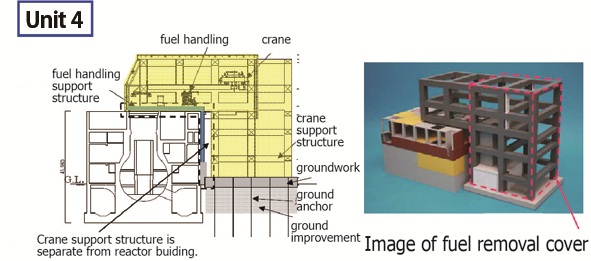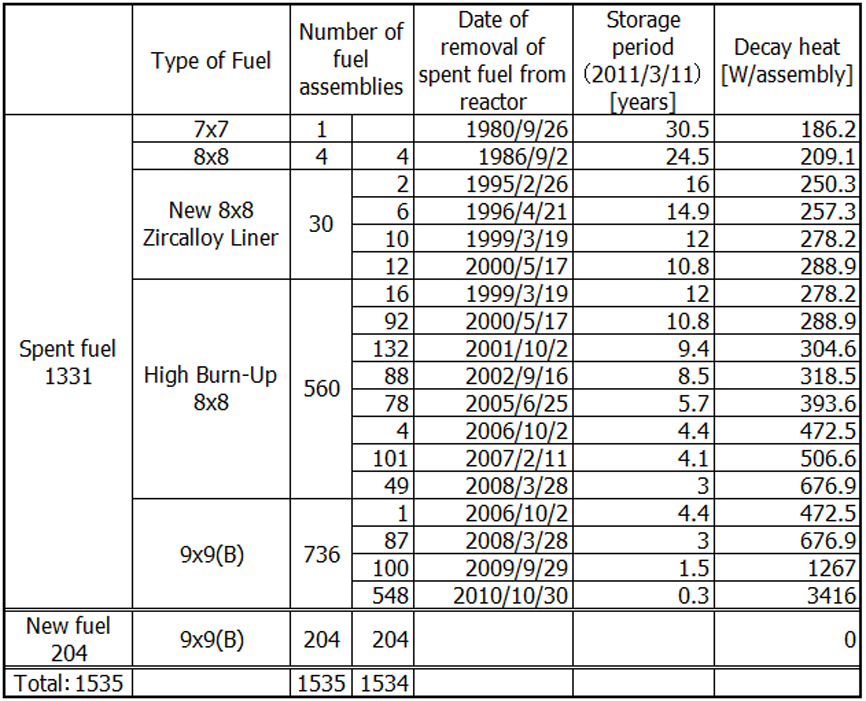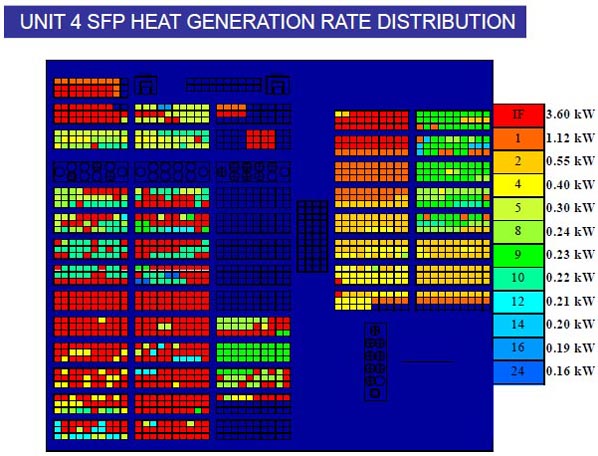Fuel in the reactors
and fuel in the spent fuel pools at F1 and F2
“Fuel removal cover” TEPCO plans to begin the work of removing fuel from the F1 Unit 4 SFP in mid-November, 2013, and to complete the work about one year later, at the end of 2014. To ensure the feasibility of the removal work, the power company transferred two new fuel assemblies from the SFP to the common pool, inspected them, and reported that they were free from corrosion and deformation. However, this is far too hasty a conclusion, since great volumes of seawater were poured into the SFP and because only two fresh fuel assemblies were inspected, not spent fuel assemblies. Because the original fuel crane and other facilities of F1 Unit 4 were destroyed in the hydrogen explosion, TEPCO plans to transfer the fuel from the SFP after removing the fifth floor of the reactor building. All the debris will then be cleared off the SFP and a structure named a fuel removal cover will be installed next to the building. The structure is planned to stand 53 meters above ground, measure about 69 meters north–south, and about 31 meters east–west (Fig. 1). According to TEPCO, the structure of the cover supporting the crane is designed so as not to place any load on the reactor building. Nevertheless, the quake resistance of the cover will not be sufficient. It is planned to transfer the removed fuel assemblies to the common pool by means of two shipping casks (model NFT-22B), which have a capacity of up to 22 assemblies. Common spent fuel pool A total of 6,375 nuclear fuel assemblies are currently stored in the F1 common pool. The pool is expected to accept a total of 3,108 fuel assemblies from the SFPs of F1 Units 1 to 4 in the future. As Table 1 shows, however, the common pool has almost no extra capacity (it is about 93% full). Accordingly, about half the fuel assemblies currently in the common pool are expected to be transferred to temporary dry cask storage facilities, explained below, to provide capacity for the fuel assemblies being transferred from the SFPs. These fuel assemblies include those whose storage is not included in the construction permit of the common pool, such as spent fuel (7×7 fuel assemblies), fresh fuel (9×9 fuel assemblies), and damaged fuel, as well as almost all the variations of boiling-water reactor fuel assemblies, as shown in Table 2. The fuel assemblies being transferred from the SFPs to the common pool are assumed to be damaged or contaminated with salt, and common pool renovation is planned to maintain water quality. Dry cask storage facilities
Temporary dry cask storage facilities TEPCO plans to transfer dry storage casks and spent fuel assemblies in the common pool to a new temporary dry cask storage facility which will be built on the F1 site. This facility is scheduled to hold 20 dry storage casks (a design storage period of 40 years) and 45 dual-purpose transportation and storage casks (which can store 69 fuel assemblies each and have a design storage period of 50 years). Though the facilities are for temporary storage, they will be used for a period of 50 years. Japan is not highly experienced in the dry storage of fuel, and it is a great challenge for the country to ensure the integrity of dry-stored fuel for such a long period of time. Masako Sawai (CNIC) Return to CNIC's Earthquakes and Nuclear Power pageReturn to NIT 154 contents |

| CNIC Citizens' Nuclear Information Center Akebonobashi Co-op 2F-B, 8-5 Sumiyoshi-cho, Shinjuku-ku, Tokyo, 162-0065, Japan TEL.03-3357-3800 FAX.03-3357-3801 Map http://cnic.jp/english/ |




